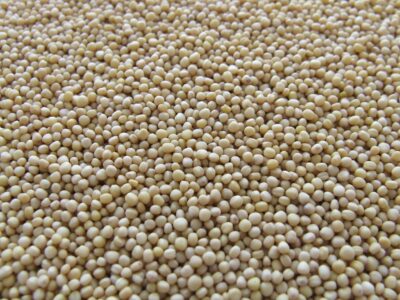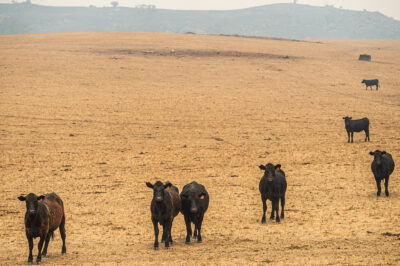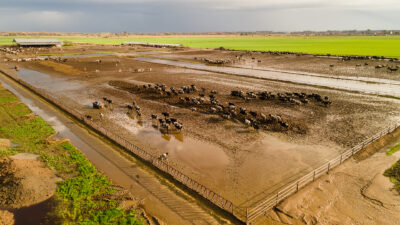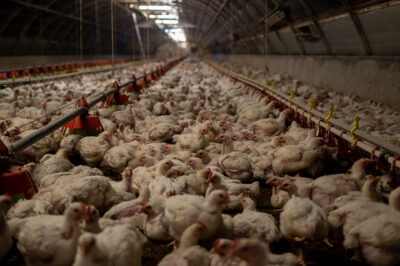Soya is a hugely important crop globally, but its widespread use as animal feed has caused production to rise dramatically and led to significant environmental damage, much of it through deforestation. When eaten directly by humans, soya is an efficient and nutritious source of protein, but when grown as feed it becomes part of the far more wasteful system of animal agriculture, with its high demands for water and land, massive pollution, and unsustainable carbon emissions.
WHAT IS SOYA?
Soya comes from soya beans, a type of legume native to East Asia but now grown in many places around the world. These beans are used to make many foods for humans including soya milk, tofu, and meat alternatives, and are fermented to make products like soy sauce and tempeh. They are also used in many non-food products, including biodiesel to replace petrol in vehicles, cosmetics, insulation, and vehicle tyres. But the main use of soya today is as feed for farmed animals.
Soya beans can be eaten by humans and animals whole, but they are mostly processed and separated into soya bean meal and soya oil (80 per cent and 20 per cent of a soya bean, respectively). Soya meal mostly becomes animal feed while the oil is used in human food and non-edible products.
WHERE IS SOYA GROWN?
SOYA BEAN PRODUCTION BY COUNTRY
Data on soya production by country is collected by the United Nations Food and Agriculture Organization and can be found at Our World in Data. Below are the countries that produced a million or more tons in 2020:
Brazil: 121.8m
United States: 112.5m
Argentina: 48.8m
China: 19.6m
India: 11.2m
Paraguay: 11m
Canada: 6.4m
Russia: 4.3m
Bolivia: 2.8m
Ukraine: 2.8m
Uruguay: 2m
South Africa: 1.2m
Indonesia: 1m
Italy: 1m
As a whole, the European Union produced 2.7m tons.
WHICH COUNTRIES PRODUCE THE MOST SOYA?
Global soya production used to be dominated by the US, but since the 1980s Brazil has steadily overtaken it to become the largest producer. Brazil has nearly doubled its soya harvest in that time, due to new cultivation techniques, increasing use of pesticides, and huge amounts of deforestation (more on that later). In 2020, not only was Brazil the world’s biggest soya exporter, soya was also its number one export, with China being its main customer.
The US originally took the mantle of world’s biggest soya producer from China in the 20th century after players including the Department of Agriculture (USDA) and the businessman Henry Ford became determined to cultivate the crop. In the 1930s and 1940s, significant investment was made in equipment and technology for processing soya beans, while large areas of cropland were repurposed to grow soya. Its ability to fix nitrogen in the soil made it a good complement to the other major crop grown in the US, corn, which depletes soil nitrogen. These are among the factors that made soya such a big part of the agricultural economy of the US.
While Argentina grew more soya than any other crop during the early 2000s, it has lately been shifting towards growing more corn and wheat. The 52m tons of soya it harvested in 2021 is down from a peak of 58.5m tons in 2015 to 2016, with farmers opting for corn or wheat instead. These alternative crops are commanding better prices, but also avoid the long-term soil erosion and other farming difficulties caused by soya monocropping.
China has been growing soya beans for thousands of years, but it wasn’t until China began “opening up” to the rest of the world in 1978, and the government started transitioning China towards a diet based more on meat and milk, that soya beans became a key source of animal feed, boosting demand. But there is now a gap between how much soya China produces and how much it uses for animal feed, making it the world’s biggest importer of soya. The Chinese government now plans to increase domestic production by 40 per cent by 2025.
HOW HAS DEMAND FOR SOYA CHANGED OVER TIME?
Demand for soya has increased greatly, particularly over the past few decades, as it has become a staple part of the diets of intensively farmed animals, with its high protein content promoting fast growth. The world produces 13 times more soya today than it did in the 1960s, from between 20m and 30m tons per year to 350m tons. Production has doubled since the start of the 21st century alone.
WHICH INDUSTRY USES THE MOST SOYA?
A massive 77 per cent of soya grown globally is used for feeding farmed animals. The poultry sector is the biggest consumer, accounting for 37 per cent of soya used for feed, while farmed pigs eat 20.2 per cent. In the UK, 60 per cent of imported soya is used to feed farmed birds, mostly chickens.
By comparison, direct human consumption only accounts for 20 per cent of soya, mostly in the form of oil which is used in processed food products and in the cooking oil at some fast-food restaurants. Tofu, tempeh, soya milk, and other foods made with soya beans account for a mere 6.9 per cent of soya use.
More than five per cent of soya is used to feed farmed fish, and is the biggest source of protein in aquaculture. The fish farming industry is expected to keep growing, as will its dependence on soya.
DOES SOYA CONTRIBUTE TO DEFORESTATION?
HOW IS SOYA DESTROYING THE RAINFOREST?
Historically, soya helped to drive deforestation directly, particularly in the Amazon, but since Brazil’s Soya Moratorium was agreed in 2006, limiting sale of soya grown on deforested land, soya production has expanded into land that was originally cleared for grazing cattle instead. Soya is thus still driving up demand for land overall and indirectly fueling deforestation for pasture. One study from 2020 found that of the soya imported to the European Union from the Brazilian Amazon and Cerrado (the world’s most biodiverse savanna), about a fifth came from land that had been deforested after 2008 — after the Soya Moratorium — and most likely illegally.
About 20 per cent of the Gran Chaco, a dry forest spanning about 650,000 sq km across Argentina, Paraguay, Bolivia, and Brazil, was converted into farmland or grazing land from 1985 to 2013, with most of this deforestation taking place in Argentina. During the 2000s, soya bean production was a direct driver, and may also have indirectly caused deforestation in the Bolivian and Paraguayan Chaco, possibly because soya farms expanded into grazing pasture, resulting in further conversion of forest to grazing land.
WHAT PERCENTAGE OF DEFORESTATION IS CAUSED BY SOYA?
The answer to this is not so straightforward, given that soya has been both a direct and indirect driver of deforestation. But about 85m hectares of Amazon rainforest, or 13.2 per cent of the forest’s original extent, has been lost through deforestation and other causes in total, with 1.33m hectares destroyed to grow crops, including soya, between 2001 and 2013.
HOW CAN WE STOP USING SOYA LINKED TO DEFORESTATION?
SWITCH TO A VEGAN DIET
Because most soya is fed to farmed animals, the best way to avoid soya that could be linked to deforestation is to eat a vegan diet. And this responsibility goes beyond individual consumers. As Anna Jones, head of forests at Greenpeace, told The Guardian in 2020, “The only way supermarkets and fast food companies will actually achieve deforestation-free supply chains is by reducing the amount of meat they sell, not by replacing soya with other feeds, or by paying certification schemes.”
CREATE DEMAND FOR SUSTAINABLE PRODUCTS
There has been a huge rise in interest in sustainable products over the past few years as people have become more aware of the global climate and nature crises. One type of sustainable product that has seen growing demand is vegan food items, with sales of plant-based meat alternatives in the UK having grown 40 per cent between 2014 and 2019. The more people reduce their meat consumption, the more this demand will grow, with challenges like Veganuary helping to boost interest in plant-based food.
ENCOURAGE COMPANIES TO USE SUSTAINABLE SOYA
Some companies are making commitments to source soya that is not only deforestation-free but also sustainably produced. Sainsbury’s, for example, says that its new approach to sustainable soya “looks not only to ensure that our [soya is] verified deforestation and conversion free, but to encourage the companies in our supply chains to adopt better production and sourcing practices.” But as long as soya is being fed to farmed animals, it is still contributing to the many environmental, animal welfare, and public health problems created by the meat industry.
INVEST IN ALTERNATIVE PROTEIN SOURCES
To help more people switch to plant-based diets, better investment in alternative sources of protein is needed. A 2021 report by the Social Market Foundation urged the UK government to “demonstrate bold and clear leadership on the need to reduce meat intake if it is serious about its Net Zero commitments”, by boosting funding for the alternative protein market. Similarly, according to Boston Consulting Group, “alternative proteins will represent 11 per cent of all protein consumption by 2035, and with some help from technology, investors, and regulators, alternative proteins could command 22 per cent of the global market over this time frame.”
SUPPORT CONSERVATION ORGANISATIONS
Conservation organisations like Amazon Conservation can be a good way to help protect rainforests from illegal deforestation, as one type of work they do is to train Indigenous communities to use drones to monitor the forest and gather other evidence of deforestation that can help governments take action against it.
SUPPORT POLICIES AND REGULATIONS
Policies that help to reduce meat consumption and boost support for alternative proteins are key. These could be local, for example if your school, university, or workplace wanted to introduce more plant-based options onto its menu. Or they could be at the national level, such as the introduction of eco-labelling for food and improved dietary guidelines.
SUPPORT SUSTAINABLE SOYA PRODUCTION
Avoiding meat is one way to avoid deforestation-linked soya. For other soya products, like tofu and soya milk, you can check where and how the soya is grown. For example, Alpro sources 60 per cent of its soya from Europe, where it is grown on rotation, not in a monoculture, with as little fertiliser as possible.
CONCLUSION
The use of soya to feed farmed animals has made it a far more environmentally destructive crop than it needs to be. With so little soya being used for direct human consumption, it’s clear that soya could be produced in a much more sustainable way if it weren’t mostly grown as animal feed. Brazil and Argentina in particular, which produce huge amounts of soya for export and are high-risk areas for deforestation, should not bear the environmental costs of the global demand for meat.
